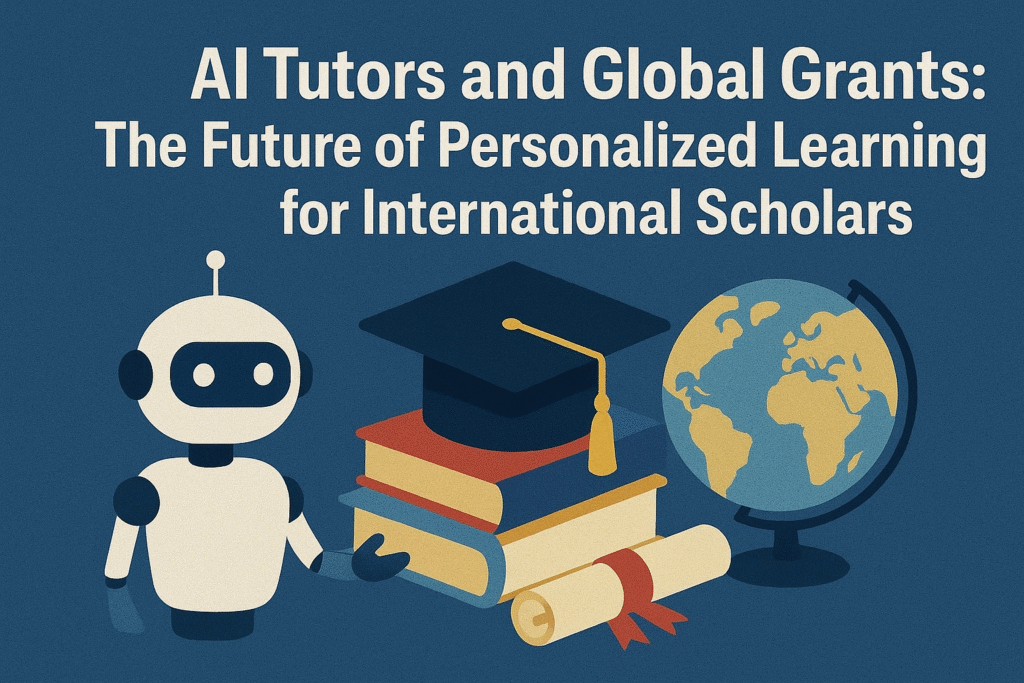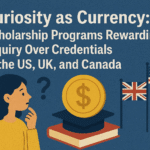Discover how AI tutors are revolutionizing personalized learning for international students. Explore the rise of global grants funding this tech-driven educational shift and how it’s creating a more equitable future for scholars worldwide.
Bridging the Global Education Divide
The dream of an international education has long been a powerful engine for global mobility, cultural exchange, and intellectual advancement. Yet, for millions of talented students worldwide, this dream remains out of reach, hindered by formidable barriers: prohibitive costs, rigid educational systems, and a one-size-fits-all approach to teaching that fails to account for individual needs, learning paces, and cultural contexts.
A dual-force revolution is now shattering these barriers, promising to democratize elite education on an unprecedented scale. On one front, a new wave of global grants and philanthropic funding is specifically targeting access and innovation. On the other, a technological tsunami led by artificial intelligence is providing the tool to deliver on that promise. At the confluence of these two trends lies the most transformative educational tool of our time: the AI tutor.
This is not the dystopian vision of robots replacing teachers. Instead, it is the emergence of intelligent, adaptive, and infinitely patient digital mentors capable of delivering truly personalized learning to any student, anywhere, at any time. For the international scholar—navigating a new academic system, potentially in a second language, and often alone—this technology is more than a convenience; it is a lifeline. This article explores how the synergy of targeted funding and cutting-edge AI is crafting a new, more equitable future for global education, creating a world where geographic and socioeconomic status no longer dictate academic destiny.
The Limitation of the Past – Why Traditional Models Fail International Students
To appreciate the revolution, one must understand the problems inherent in the old system.
1. The “Sage on the Stage” Model:
Traditional lecture-hall education is fundamentally passive. It assumes a uniform pace of learning and a single, optimal way to absorb information. For an international student struggling with language fluency or unfamiliar with a specific teaching style, this model is a recipe for falling behind. There is no pause button, no rewind, and little opportunity for personalized clarification.
2. The Isolation and Support Gap:
Moving across the world to study is intensely stressful. Beyond academics, students face cultural shock, social isolation, and the pressure to succeed in a high-stakes environment. University support services, like tutoring centers and office hours, are often overwhelmed. Seeking help can feel intimidating, especially for students from cultures where admitting struggle is stigmatized.
3. The Financial Chasm:
Tuition for international students is often double or triple the rate for domestic peers. The cost of living in global education hubs like the US, UK, Canada, and Australia is astronomical. While scholarships exist, they are fiercely competitive and rarely cover full expenses, forcing students into demanding part-time work that further eats into study time.
4. Standardized Testing Barriers:
Exams like the TOEFL, IELTS, GRE, and GMAT are expensive, high-pressure gatekeepers. Preparing for them often requires costly coaching centers, creating another financial and logistical hurdle for talented students from low-income backgrounds.
This system left a vast reservoir of global talent untapped. AI tutors and the new funding models supporting them are designed to tap it.
The Rise of the Digital Mentor – What is an AI Tutor?
An AI tutor is not a simple chatbot or a pre-recorded video lecture. It is a sophisticated software platform powered by a suite of technologies.
Core Technologies:
- Machine Learning (ML) and Adaptive Learning Algorithms: The core of personalization. The system analyzes a student’s responses—right, wrong, hesitant, fast, slow—to build a unique model of their knowledge state. It identifies strengths, gaps in understanding, and optimal learning pathways.
- Natural Language Processing (NLP): Allows the tutor to understand free-form text and voice inputs from the student. This enables natural, conversational Q&A, essay feedback, and language practice.
- Large Language Models (LLMs): Models like GPT-4 provide the vast knowledge base and generative capability to answer a wide range of questions, generate practice problems, and explain concepts in countless different ways.
- Data Analytics: Continuously tracks progress on a granular level, providing the student and their human teachers with actionable insights.
Capabilities of a Modern AI Tutor:
- 24/7 Socratic Dialogue: A student can ask “why?” a hundred times at 2 a.m. without fear of judgment. The AI patiently explains concepts from different angles until comprehension is achieved.
- Customized Pacing and Content: The tutor adapts in real-time. If a student masters algebra quickly, it moves them to calculus. If they struggle with a specific physics concept, it provides additional exercises, videos, and analogies.
- Multimodal Instruction: Explains a concept through text, generates a diagram, recommends a video, and then creates a quick quiz to check for understanding—all tailored to the learner’s preferred style.
- Automated Assessment and Feedback: Can grade assignments, provide instant feedback on essays (grammar, structure, argument strength), and even code, freeing human professors for higher-value interactions.
For an international student, this means on-demand support that is tailored to their specific learning gaps and language proficiency.
The Funding Revolution – Global Grants for a Digital Education
Technology alone is not enough. The access gap is also a funding gap. Recognizing this, a new generation of grants and initiatives is emerging.
1. Philanthropic Foundations:
- The Chan Zuckerberg Initiative: Has invested heavily in personalized learning tools that leverage AI, focusing on their potential to reach underserved communities globally.
- The Bill & Melinda Gates Foundation: Funds initiatives aimed at using technology to improve educational outcomes and increase college readiness, particularly for low-income and minority students, a category that includes many international scholars.
- Open Society Foundations: Supports programs that promote access to education and the development of digital learning resources for students in developing countries.
2. University-Led Digital Initiatives:
Elite universities are launching their own funded programs to attract and support a diverse global student body.
- MIT’s J-WEL: The Abdul Latif Jameel World Education Lab promotes innovation in education through grants and collaborations, often focused on digital and online learning.
- Stanford’s Seed Grants: Fund projects that explore the use of AI in teaching and learning, with many projects having global applications.
3. Government and NGO Scholarships for Digital Access:
- Fulbright Program: While traditional, it’s increasingly supporting projects and studies related to EdTech and digital education.
- Chevening Scholarships (UK), Erasmus+ (EU): These large-scale programs are incorporating support for digital resources and online learning components, acknowledging their role in modern education.
- World Bank and UNESCO Grants: Fund large-scale projects to implement digital learning infrastructure and training in developing nations, creating the foundation upon which AI tutors can operate.
These global grants are no longer just funding tuition; they are funding the technological ecosystem—internet access, devices, and software licenses—that makes participation in modern education possible.
The Symbiosis – How AI Tutors and Grants Create Powerful Outcomes
The true power is unleashed when funding and technology work together.
Use Case 1: The Pre-Arrival Bootcamp
- The Problem: A student from Vietnam gets a full scholarship to a Canadian university but is anxious about her academic writing and presentation skills in English.
- The Solution: The scholarship includes access to a pre-semester AI tutor program. For two months before she travels, she practices with an AI that:
- Reviews her essays and provides feedback on grammar, tone, and argument structure.
- Simulates Q&A sessions for class participation.
- Offers micro-lessons on Western academic citation styles (APA, MLA).
- The Outcome: She arrives on campus confident, prepared, and ready to engage, dramatically increasing her chances of success.
Use Case 2: The In-Course Support System
- The Problem: A gifted engineering student from Kenya at a UK university is struggling with a complex thermodynamics module. He’s too shy to constantly ask for help in lectures.
- The Solution: The university, using grant money, has a campus-wide license for an AI tutor platform. That night, he logs in and has a conversational deep-dive with his AI tutor, which identifies his specific misunderstanding about entropy and walks him through it with custom-drawn diagrams and practice problems.
- The Outcome: He overcomes the hurdle without falling behind, and the system alerts his human professor to the class’s general difficulty with that concept, allowing for a targeted review.
Use Case 3: The Language and Cultural Coach
- The Problem: A Brazilian student in the US understands academic English but struggles with slang, idioms, and cultural references in social settings, leading to isolation.
- The Solution: Her AI tutor has a “cultural immersion” mode. She can ask, “What does ‘throw shade’ mean?” or “How should I respond if someone says ‘sup?'” The AI explains the context, tone, and appropriate responses.
- The Outcome: She gains confidence in everyday interactions, helping her build a social network and feel more integrated.
Challenges and Ethical Considerations
This future is not without its pitfalls. Responsible implementation is key.
- The Digital Divide: AI tutors require reliable, high-speed internet and a capable device. Grants must explicitly fund this infrastructure to avoid creating a new form of inequality.
- Data Privacy and Security: These systems collect vast amounts of sensitive data on how a student learns, thinks, and struggles. Robust, transparent data governance policies are non-negotiable.
- The Human Element: AI must augment, not replace, human teachers. The goal is to free educators from repetitive tasks (grading, basic Q&A) to focus on mentorship, inspiration, complex discussion, and providing the emotional support that only a human can give.
- Algorithmic Bias: AI models are trained on data that can contain cultural and linguistic biases. Continuous auditing is required to ensure the tutor does not perpetuate harmful stereotypes or fail to understand diverse contexts.
The Future – A Hyper-Personalized Global Campus
The trajectory points toward an even more integrated and immersive future.
- AI-Powered Grant Matching: Future platforms could use AI to match international students with the perfect global grants and scholarships based on their profile, academic interests, and background, simplifying the discovery process.
- Multilingual, Multicultural AI Tutors: Tutors will become truly polyglot, seamlessly switching languages to explain a complex concept in a student’s native tongue before practicing it in English.
- VR/AR Integration: Imagine an international scholar putting on a VR headset to conduct a chemistry experiment in a virtual lab with their AI tutor guiding them, or exploring ancient Rome in a history class—all from their home country before they even depart.
- Lifelong Learning Companions: The AI tutor won’t end at graduation. It could evolve into a career coach, helping a scholar navigate postgraduate opportunities, global job markets, and continuous skill development throughout their life.
Conclusion: Democratizing Genius
The convergence of AI tutors and mission-driven global grants represents the most significant opportunity in centuries to level the global educational playing field. It moves us from a model of scarcity—where elite education is a scarce resource reserved for the few with the right passport, bank account, or test-taking skills—to one of abundance.
It creates a world where a brilliant mind in a remote village has the same access to personalized learning as a student in a capital city. It ensures that the financial and academic support to nurture that brilliance is becoming more accessible every day. This is not just about making education more efficient; it is about making it more human, more supportive, and more just. By providing every international scholar with a personalized digital mentor and the means to access it, we aren’t just changing how we teach—we are unlocking the world’s full intellectual potential, one student at a time.


